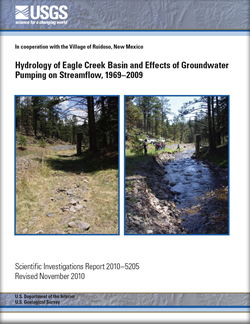Scientific Investigations Report 2010–5205

Urban and resort development and drought conditions have placed increasing demands on the surface-water and groundwater resources of the Eagle Creek Basin, south-central New Mexico. The Village of Ruidoso, N. Mex., obtains 60–70 percent of its water from the Eagle Creek Basin. The village drilled four production wells on Forest Service land along North Fork Eagle Creek; three of the four wells were put into service in 1988 and remain in use. Local citizens have raised questions as to the effects of North Fork well pumping on flow in Eagle Creek. In response to these concerns, the U.S. Geological Survey, in cooperation with the Village of Ruidoso, conducted a hydrologic investigation from 2007 through 2009 of the potential effect of the North Fork well field on streamflow in North Fork Eagle Creek. Mean annual precipitation for the period of record (1942–2008) at the Ruidoso climate station is 22.21 inches per year with a range from 12.27 inches in 1970 to 34.81 inches in 1965. Base-flow analysis indicates that the 1970–80 mean annual discharge, direct runoff, and base flow were 2,260, 1,440, and 819 acre-feet/year, respectively, and for 1989–2008 were 1,290, 871, and 417 acre-feet/year, respectively. These results indicate that mean annual discharge, direct runoff, and base flow were less during the 1989–2008 period than during the 1970–80 period. Mean annual precipitation volume for the study area was estimated to be 12,200 acre-feet. Estimated annual evapotranspiration for the study area ranged from 8,730 to 8,890 acre-feet. Estimated annual basin yield for the study area was 3,390 acre-feet or about 28 percent of precipitation. On the basis of basin-yield computations, annual recharge was estimated to be 1,950 acre-feet, about 16 percent of precipitation. Using a chloride mass-balance method, groundwater recharge over the study area was estimated to average 490 acre-feet, about 4.0 percent of precipitation. Because the North Fork wells began pumping in 1988, 1969–80 represents the pre-groundwater-pumping period, and 1988–2009 represents the groundwater-pumping period. The 5-year moving average for precipitation at the Ruidoso climate station shows years of below-average precipitation during both time periods, but no days of zero flow were recorded for the 11-year period 1970–80 and no-flow days were recorded in 11 of 20 years for the 1988–2009 period. Results of the Mann-Whitney test indicate that the median annual discharge was not significantly different between the periods 1970–79 and 1989–2008, but median monthly discharges were significantly less for 7 of 12 months from 1989 to 2008 as compared to 1970–79. The 1970–79 and 1989–2008 exceedance curves are similar at the highest discharge values but diverge for the remainder of the record, with 1970–79 discharge being greater than 1989–2008 discharge for a given probability of occurrence. The 1989–2008 exceedance curve declines more rapidly than does the 1970–79 curve, reflecting less available sustained base flow than for the earlier period. Variation in the location of the end of perennial flow, expressed as distance downstream from the North Fork gaging station, was compared to daily average discharge at the gaging station on the date of the survey. The few data available indicate that streamflow infiltrates into bedrock in the streambed about 1,600 feet downstream from the North Fork gaging station, where it is available to recharge the bedrock aquifer. The streambed in this reach appears to have a capacity to transmit water at a threshold rate of about 0.7–1 cubic feet per second (ft³/s). The amount of water needed to saturate the alluvium to the bottom of the stream channel at its greatest cross-sectional area between the North Fork and Eagle Creek gages was estimated by using Darcy’s law to range from 0.6 ft³/s to 1.2 ft³/s. The observed coarse nature of the alluvium would indicate that the actual hydraulic conductivity is likely nearer the higher range of hydraulic conductivity values, requiring a discharge of 1.2 ft³/s to saturate the alluvium to the bottom of the stream channel. Sustained flows greater than 2.2 ft³/s (threshold rate of 1.0 plus 1.2 ft³/s) are needed to saturate the alluvium and maintain continuous flow in the North Fork. In the 19-month period of record from September 2007 through March 2009, 2.2 ft³/s of discharge was equaled or exceeded at the North Fork gaging station 2 percent of the time. If it is assumed that, without pumping, the bedrock aquifer would be saturated to the base of the alluvium, then a discharge of only 1.2 ft³/s required to saturate the alluvium in its thickest and widest reach would be needed to sustain continuous flow in the stream. During the study period, a discharge of 1.2 ft³/s was equaled or exceeded at the North Fork gaging station 8 percent of the time. Based on the discharge record at the Eagle Creek gage, given alluvium and channel configurations similar to those described in this study, streamflow in some part of the stream channel between the North Fork and Eagle Creek gages was likely discontinuous during part of the year during both time periods. View report for unabridged abstract. |
First posted October 21, 2010 For additional information contact: Part or all of this report is presented in Portable Document Format (PDF); the latest version of Adobe Reader or similar software is required to view it. Download the latest version of Adobe Reader, free of charge. |
Matherne, A.M., Myers, N.C., and McCoy, K.J., 2010, Hydrology of Eagle Creek Basin and effects of groundwater pumping on streamflow, 1969–2009: U.S. Geological Survey Scientific Investigations Report 2010–5205, 73 p. (Revised November 2011)
Acknowledgments
Conversion Factors
Abstract
Introduction
Methods
Hydrology of the Eagle Creek Basin Study Area
Hydrology of North Fork Eagle Creek
Effects of Groundwater Pumping on Streamflow
Summary
References Cited
Appendix 1. Well-completion details for monitoring wells MW-1A, MW-1B, MW-1C, MW-2A, MW-3A, MW-4B, MW-4C, and MW-5A near North Fork Eagle Creek, New Mexico